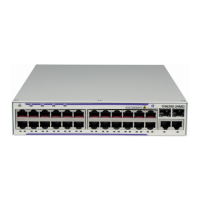Label Distribution Protocol
Page 250 7210 SAS M, T, X, R6, Mxp MPLS Configu-
ration Guide
C) If there is more than one LFA next-hop within the selected type, then it will pick one
based on the least cost.
D) If more than one LFA next-hop with equal cost results from Step C, SPF will select the
first one from the remaining set. This is not a deterministic selection and will vary
following each SPF calculation.
E) If no LFA next-hop results from Step D, SPF will rerun Steps B-D using the second set.
Note this algorithm is more flexible than strictly applying Rule 3 above; the link protect rule in the
presence of a PN and specified in RFC 5286. A node-protect LFA which does not avoid the PN;
does not guarantee link protection, can still be selected as a last resort. The same thing, a link-
protect LFA which does not avoid the PN may still be selected as a last resort.Both the computed
primary next-hop and LFA next-hop for a given prefix are programmed into RTM.
Multi-Area and Multi-Instance Extensions to LDP
To extend LDP across multiple areas of an IGP instance or across multiple IGP instances, the
current standard LDP implementation based on RFC 3036 requires that all the /32 prefixes of PEs
be leaked between the areas or instances. This is because an exact match of the prefix in the
routing table has to install the prefix binding in the LDP Forwarding Information Base (FIB).
Multi-area and multi-instance extensions to LDP provide an optional behavior by which LDP
installs a prefix binding in the LDP FIB by simply performing a longest prefix match with an
aggregate prefix in the routing table (RIB). The ABR is configured to summarize the /32 prefixes
of PE routers. This method is compliant to RFC 5283- LDP Extension for Inter-Area Label
Switched Paths (LSPs).

